
Academy 1/48 MiG-29A Fulcrum
| KIT #: | 2116 |
| PRICE: | €29.00 |
| DECALS: | Two options |
| REVIEWERS: | Spyros Vakatatsis & Kyriakos Labropoulos |
| NOTES: | Eagle Strike 48-013 decals, True Details resin seats |

IF YOU ARE GOOD AT SOMETHING…………STICK TO IT!
| HISTORY |
The MiG-29 originated from a Prospective Frontal Fighter program launched in 1969, the Perspektivnyi Frontovoi Istrebeitel (PFI), which was later split into two separate programs, the Loggiky Perspektivnyi Frontovoi Istrebeitel (LPFI) – Lightweight aircraft and then Tyazholyi Perspektivnyi Frontovoi Istrebeitel (TPFI) – Heavyweight aircraft (the latter eventually leading to the Sukhoi Su-27). Aiming to counter the F-15 – the winner of USAD’s FX program – it was designed by the Mikoyan OKB. The MiG-29 has emerged as a supreme air defense fighter, optimized for agility but with limited range, endurance and payload.
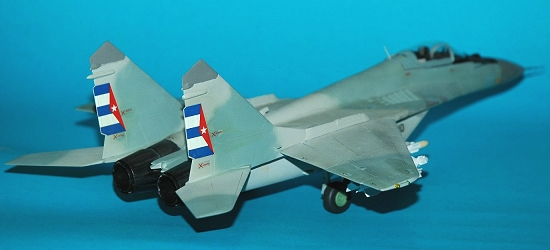 The new fighter design was powered by 2
Klimov RD-33 afterburning augmented bypass turbojet engines: each rated at
11,110 lb st and boosted to 18,298 lb st with afterburning. It had twin
fin/high-wing configuration and featured blended wing and fuselage
arrangement. The aircraft was equipped with a N-019 “look-down/shoot-down”
coherent pulse-Doppler radar, SRZ IFF (‘Odd Rods’), whereas the cockpit
included a small screen for radar display and a narrow-angle HUD. For the
most part, the rest was typical of early 80s fighter cockpit style with
only limited HOTAS controls. Armament comprised of one 30-mm GSh-30-1 gun
and a choice of radar-guided R-27 (AA-10 ‘Alamo’) and IR-homing R-73 (AA-11
‘Archer’) air-to-air missiles.
The new fighter design was powered by 2
Klimov RD-33 afterburning augmented bypass turbojet engines: each rated at
11,110 lb st and boosted to 18,298 lb st with afterburning. It had twin
fin/high-wing configuration and featured blended wing and fuselage
arrangement. The aircraft was equipped with a N-019 “look-down/shoot-down”
coherent pulse-Doppler radar, SRZ IFF (‘Odd Rods’), whereas the cockpit
included a small screen for radar display and a narrow-angle HUD. For the
most part, the rest was typical of early 80s fighter cockpit style with
only limited HOTAS controls. Armament comprised of one 30-mm GSh-30-1 gun
and a choice of radar-guided R-27 (AA-10 ‘Alamo’) and IR-homing R-73 (AA-11
‘Archer’) air-to-air missiles.
The MiG-29 ‘Fulcrum’ entered service as part of the Frontal Aviation in 1982. The first MiG-29 regiment to be formed was the 234th ‘Proskurovskii’ GvIAP at Kubinka. By 1986, MiG-29s were re-equipping regiments in East Germany, and in the same year India received its first export versions. Ever since its widespread introduction into service, the MiG-29 has spurred a number of myths regarding its capabilities, some of which were destroyed after the aircraft had been assessed by the Westerns following the reunification of Germany and the subsequent retention by the Luftwaffe of the former East German MiG-29s.
The MiG-29 has proven to be a potent
fighter with outstanding low-speed/high-alpha maneuverability, coupled with
helmet-mounted sights and a very effective close-range dogfight missile,
the Vympel R-73, which has an excellent, wide-angle seeker, with fine
target determination. The baseline R-73 can be fired at targets at up to 45o
off-bore sight and the latest versions significantly improved the launch
envelope. In general, in low-speed encounters, the MiG-29 is a respectable
opponent, whereas at long range and high speed, its limited capability
systems (radar, R-27 missiles) put it at a great disadvantage. It is worth
noting, 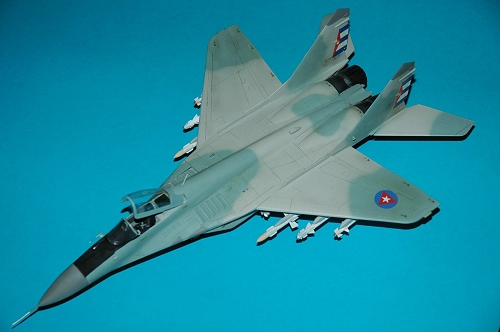 especially in light
of the technology/effectiveness-driven/network-centric warfare that
dominates the world today, that the aircraft has experienced serviceability
problems: lack of range, poor navigation system, downgraded radar equipment
for the export versions.
especially in light
of the technology/effectiveness-driven/network-centric warfare that
dominates the world today, that the aircraft has experienced serviceability
problems: lack of range, poor navigation system, downgraded radar equipment
for the export versions.
Most Russia’s Warsaw Pact allies received a sub-variant of the MiG-29 – the MiG-29A – which was almost identical to the aircrafts delivered to the Frontal Aviation. These lacked wiring for the nuclear strike role and may have had slightly downgraded versions of the radar. Germany received 20 MiG-29As and four UBs since 1988, while Czechoslovakia took 18 and 2 respectively, since 1989. Poland received 9 single-seat and 3 UBs, Bulgaria received 18 single-seat and 4 UBs, and Hungary received 24 MiG-29As and 4 UBs in 1992. After the split of Czechoslovakia, the Czechs passed their remaining 9 single-seat to the Polish Air Force in 1996; more recently, the German planes suffered the same fate. Most of the MiG-29As are now probably effectively MiG-29Bs.
The MiG-29B, similar to the single-seat MiG-29 version but lacking the full-standard IFF and datalink equipment and probably equipped with downgraded versions (N-019E) of the mainline radar, was sold to export customers other than USSR’s closest allies. MiG-29Bs were delivered to Cuba (10 MiG-29Bs and 2 MiG-29UBs), India (70 MiG-29Bs and 8 UBs), Iran (12 single-seat and 2 UBs), Iraq (35 single-seat and 6 UBs), Yugoslavia (14 single-seat and 2 UBs), North Korea (~30), and Syria (~20).
The DAAFAR, Defensa Anti-Aérea y Fuerza Aérea Revolucionaria (Revolutionary Air and Anti-Aircraft Defense Force) received its MiG-29s in 1989 and operates 10 MiG-29Bs and 2 MiG-29UBs. The aircrafts equip the 231o Escuadrón de Casa, an independent Fighter Squadron based at San Julián that belongs to Brigada de Guardia ‘Playa Giron’.
| THE KIT |
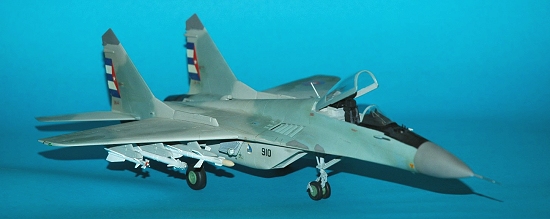 The Academy kit is the only single-seat
Mig-29 currently available in the 1/48 scale. Academy also offers a
MiG-29UB kit in the same scale. Monogram had issued a single-seat version
in the late 80s, although it had raised panel lines, and, as claimed by
some, some shape inconsistencies. Revell may reissue the kit, although they
offer a similar kit in 1/32, so don’t hold your breath.
The Academy kit is the only single-seat
Mig-29 currently available in the 1/48 scale. Academy also offers a
MiG-29UB kit in the same scale. Monogram had issued a single-seat version
in the late 80s, although it had raised panel lines, and, as claimed by
some, some shape inconsistencies. Revell may reissue the kit, although they
offer a similar kit in 1/32, so don’t hold your breath.
The Academy kit is satisfying. It has engraved panel lines, good overall shape, although those more familiar with Soviet themes may pinpoint the mistakes, and very good molding. The cockpit includes raised detail main panel and side consoles but a very basic ejection seat, not at all similar to the K-36 type carried by the actual aircraft
| CONSTRUCTION |
Notes:
We chose to present the review in the form of conversations between the two modelers, rather than follow the standard layout.
“The Usual Suspects”
Spyros “Uncle” Vakatatsis
Spyros is an ex-pharmacist, currently employed at a model shop. When it comes to building and painting figures he is an excellent modeler, but he is completely ignorant about modern jets, the latter probably adding a lot to his happiness and wellbeing. He is ambitious and very productive, but rather sloppy when it comes to assembling. He is a firm supporter of the principle “A good model is a finished model”, so most of his aircraft are built SOB (Straight Out of the Box). He is obsessed with Cuba, not for political reasons, but because it reminds him of his childhood in the ‘60s, when, as a favor to humanity, he was not modeling.
Kyriakos “Mr. Bean” Labropoulos
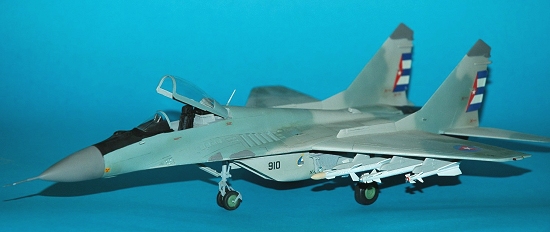 Kyriakos is a chemical
engineer who has studied in the US. He is currently living in Greece. He
could be described as more of a collector of unbuilt kits, than a modeler.
This is probably due to his obsession in finding errors in kits (see the
review of ), which works wonders as an excuse not to actually build
anything. This state is often described as AMS or Advanced Modeler
Syndrome. He loves American airplanes, especially modern jets, although he
has been recently infected with the “cute-propeller-stuff” virus, probably
as a result of spending too much time with “Uncle”. The most serious side
effect of the infection was the buy of yet more kits. He will occasionally
built something, not SOB of course, but usually with some scratch built
features or, more rarely, with aftermarket items.
Kyriakos is a chemical
engineer who has studied in the US. He is currently living in Greece. He
could be described as more of a collector of unbuilt kits, than a modeler.
This is probably due to his obsession in finding errors in kits (see the
review of ), which works wonders as an excuse not to actually build
anything. This state is often described as AMS or Advanced Modeler
Syndrome. He loves American airplanes, especially modern jets, although he
has been recently infected with the “cute-propeller-stuff” virus, probably
as a result of spending too much time with “Uncle”. The most serious side
effect of the infection was the buy of yet more kits. He will occasionally
built something, not SOB of course, but usually with some scratch built
features or, more rarely, with aftermarket items.
Eleftheria “Barbed Wire” Pinakoulaki
Eleftheria is a young archaeologist
with brilliant studies in social sciences, history and archaeology in
Athens and Paris. She is passionate of WWI themes (which is rather
surprising considering her scientific background). She makes her first
steps in (plastic) modeling and builds mainly figures in 1/35 scale. Her
favorite colors are “feld glau” and “british khaki”, but fortunately she is
not usually dressed in them. She currently lives in Athens, working in a
bi-monthly magazine about travel, vacations and tourism.
Act I
A Model Shop in Athens, Greece.
Uncle: (Casually) I’ve started building a MiG-29. It’s a really good model, and I have acquired some decals that include the ones for the Cuban Air Force. I can give you the rest of it, if you want.
Bean: (Excited, eyes wide open as he spots the possibility of a buy, perhaps even of more than one kit.) Really?! I’ve always wanted to build a MiG-29! I’ll buy one right now!!!
U: (Firmly, a bit sorry he brought the subject up.) Oh no, you won’t! First you must assemble and paint, all those kits you already have – or at least some of them – and then, maybe, I will consider selling you this one.
B: (Protesting) Yes, but…..
U: (Interrupting him) I said NO!
B: Alright, alright.
U: Anyway, as I was saying, I’ve started working on the kit. The only reason I am telling you this is that Academy indicates 3oz of weight in the cone, which I thought looked rather heavy, but I did as instructed.
 B: And?
B: And?
U: And, I was right. It was too heavy. I think the aircraft actually tilted forward! That’s not the problem though. I reopened the cone, glued less weight, and it now sits correctly but now the cone is damaged by all this gluing and cutting and re-gluing. I used superglue and accelerator to secure the weight in the cone (approx. 20g) but the styrene melted away, you see. (Pause.)
B: (Feigning indifference) Your point being?
U: I was thinking of throwing it away, unless……well, unless you can fix it by sanding the cone……
B: (Pauses, then a mischievous smile begins to form on his face.) If I do it, can I have a new MiG-29 kit?
U: (Sighing) I guess so.
B: (Pleased) You’ve just got yourself a deal.
Moral: man will go to great lengths to buy a kit
Act II
The model shop, a week later.
U: I brought the kit. Let’s see. It’s almost ready and if you fix the cone, I’ll be able to paint it and finish yet another Cuban Air Force aircraft.
B: (Adopts the cool look of an experienced professional.) Let me see.
U: Here it is. (He shows him.)
B: (Shocked) Good God, what have you done?!
U: (Quietly, a bit embarrassed) I had a bit of an accident with the glue.
B: (Voice rising) If this is your idea of a “bit of an accident”, I’d like to see what you’d call a serious one. (Almost scolding now) I have no idea how you manage to build all those marvelous “little humans” and yet do such a sloppy job with aircraft.
U: (In mock offence) They are called “figures”, you know. And, by the way, I’ve already told you I’m not good at gluing aircraft
B: Obviously… (Pauses
as he inspects the offensive item more closely.)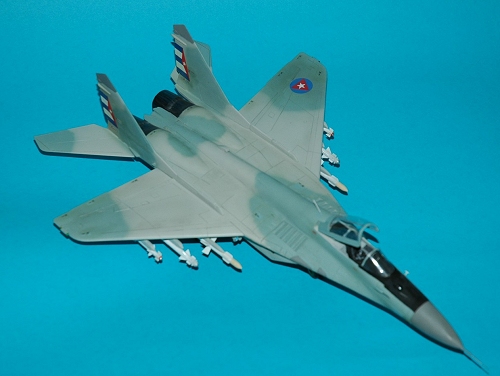
U: So… What do you think?
B: Oh, alright! I’ll do it. See what a nice guy I am?
U: Oh, I’ve just remembered, I brought you the Andrea Miniatures epoxy putty I use on my figures. Maybe you could try it on the MiG. And while we’re on the subject, what’s the difference between a MiG-29A and a MiG-29B?
B: I think the –B version is a downgraded export version of the –A, but I’ll look it up if you want. (Let it be noted that I was right. Actually, I am always right!J) And, for your information, I don’t need your putty, I’ll use my own superfine Milliput, thank you.
U: Have it your way, but if your putty doesn’t work as well as mine, don’t come crying to me! Take your time with the model – you always do, anyway! I must finish a Ju-87 Stuka, an IS-2 with its crew and soviet assault infantry, a sailing boat, a Sandinista Mil Mi 25, two figures, a P-47M and a couple of WWI biplanes.
Moral: if you are good at something………just stick to it! Additional moral: it’s always amazing to see that there are people who do not know the difference between a MiG-29A and a MiG-29B!
Act III
The model shop, 3 weeks later.
B: Hey, I brought your MiG back.
U: (Satisfied) Ah. So?
B: So? Let me tell you: fixing the cone of this model was like …. I don’t know. The only way I can put it is this: I won’t be playing the piano anytime soon.
U: (Matter-of-factly) You don’t play the piano.
B: That is not the point. Anyway, your MiG is now fixed. But I have a question: what’s with all the red, blue and green buttons in the cockpit? I have told you more times than I can remember that cockpits are not…
U and B (In unison) like Napoleonic uniforms.
U: Yes, yes, I know.
B: Granted, they are exciting, but you do not need to paint them like a circus tent.
U: (Half-serious) Are you implying something about my figure painting?
B: Of course not. In any case, the discussion on the visual aspect of Napoleonic uniforms will just have to wait for another day. Now, can we get back to the buttons in the cockpit, please? Why did you paint them in Technicolor?
U: (He hesitates. He tries to come up with a reasonable excuse, but fails.) Well, it looked good……
B: (Laughs)…to
you probably! Well, be grateful I fixed that as well. I painted the
instrument panels black and dry-brushed them with a light grey color. I
used Tamiya’s X-25 clear green for the radar scope and left all the
excitement of adding some red buttons to you. I kept the supposedly K-36
ejection-seat. I will try to scratch-build a couple of them so that they
actually look more like the K-36, rather than the sofa-like seat that the
kit offers.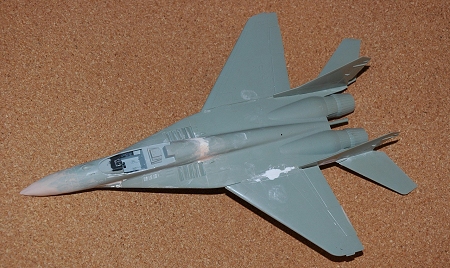
U: Good job on the cone. But what are those white and brown patches on the aircraft’s surface?
B: It’s putty. Just so you know, I did try the Andrea Miniature putty but I liked neither its color nor its smell, so I used my tried and true Milliput instead and I think it worked better. I didn’t just work on the cone; I worked on the whole aircraft: I sanded most of its surface and used some Mr. Surfacer to close all these gaps that resulted from bad fitting. I even had to remove the wings, as you had glued them in a slightly upwards position. The MiG is not a Corsair you know! I attached them as best I could, horizontally. I think that is how they should be attached, at least according to various photos and drawings I found. Well, generally speaking, I find the Academy fitting a bit off. (Smiling) On the other hand, you assembled it, so…
U: (Pleased) Well, thank you. I can now go ahead and paint it.
Moral: if you do a sloppy job with gluing, you will have a hard time sanding and fixing the mistakes…unless of course you find somebody else to do it for you! (Editor’s Note: don’t you get any ideas, now!)
Act IV
Mr. Bean’s office.
Mr. Bean, sitting, examines the stacks of paper on his desk, wondering if he’ll be able to meet his deadline. The phone rings.
B: Hello?
U: Hey there, Mr. Bean.
B: Good morning, Uncle. How are you?
 U: I’m good. Hey, I
was wondering if you’ve built the new seat for the MiG, or should we go
ahead and order some “retsina” K-36 seats? (Note: retsina is a
traditional Greek wine, but sounds pretty much the same as resin, a
well-known polymer for modelers.)
U: I’m good. Hey, I
was wondering if you’ve built the new seat for the MiG, or should we go
ahead and order some “retsina” K-36 seats? (Note: retsina is a
traditional Greek wine, but sounds pretty much the same as resin, a
well-known polymer for modelers.)
B: (Pauses. He has completely forgotten about it.) Hmm, well, see, I’ve been really busy lately, work, you know how it is. But I’ll build you one soon, I promise.
U: Yes, but I’m almost finished with it, so I need one pronto, you know, like yesterday.
(Mr. Bean doesn’t answer.)
U: Ah, never mind. I’ll just have to order the “retsina” seats.
B: (Correcting him, trying to get the upper hand in the conversation.) You mean the resin seats…Which ones?
U: True details TD48404 Soviet K-36DM ejection seats.
Moral: you shouldn’t expect an AMS modeler to actually finish something they promised on time. If they did, the aftermarket-goodies companies would go out of business!
| COLORS & MARKINGS |
Act V
The model shop.
U: (Excited) Hey, you know, I am almost done with the painting.
B: (Wallowing in self pity) I don’t care about that… I don’t care about anything anymore… The only thing that matters is she doesn’t love me!
U: (Gives him a surprised look. Then, almost impatiently) Yes, but we are talking about my MiG now, you know!
B: I’m sorry, but I just not in the mood to hear about aircraft models. I’m telling you she doesn’t love me, can’t you be just a little sympathetic?
U: (A little softer, trying to help) Maybe you should trying focusing on something positive… like my MiG-29, for instance…
B: (Now it’s his turn to give him a surprised look.)
U: (Matter-of-factly) Look, you know it as well as I do, time heals everything. And isn’t it better to do something for you, to get your mind off her, to boost your self esteem. I’m sure it will do you good. Now, that’s where the MiG comes in! Can’t you see I’m doing you a favor?
 B: (He’s not
convinced, but is half-amused and half-touched by the reaction.) Ok,
the “time heals” motto, I can buy. Now explain to me exactly
how
painting a MiG-29 will help me forget her?
B: (He’s not
convinced, but is half-amused and half-touched by the reaction.) Ok,
the “time heals” motto, I can buy. Now explain to me exactly
how
painting a MiG-29 will help me forget her?
U: Well, perhaps it will not actually help you forget her, but – bright side? – you’ll have a nicely painted MiG!
(Mr. Bean smiles, then decides that Uncle may have a point.)
U: (Impatient) Well, don’t you want me to tell you how I painted it?
B: (Resigned) Not really, as you’ll probably blurt out another great theory. You can give me the painting description instead!
U: (Pauses, then with a look of satisfaction and accomplishment) Ok, here it goes. According to the Eagle Strike decal instructions the painting scheme of DAAFAR MiG-29s consists of two colors. The main one is light grey. Eagle Strike suggested Testors’ 2133 Fulcrum gray and I had no reason to use anything else. For the second color RLM78 Hellblau is suggested, which I found rather socking for me as I didn’t expect DAAFAR used such a color on a modern Soviet jet. Therefore I used Testors’ 2134 Fulcrum grey-green. I believe this color combination is more representative as it’s also carried by Russian aircraft.
B: You disappoint me. I would expect more research from somebody with your knowledge of colors.
U: Yes, but there are not many references available. Apart from the Eagle Strike instructions, we only have a couple of photos.
B: Ah, excuses, always excuses. Did you at least do any pre-shading, any fading of colors or any kind of weathering?
U: Not really. (Mock haughty) These are for AMS modelers. Anyway, I still think we don’t know the exact colors used or their degree of weathering. I guess these colors cannot stand intact for a long time under the Caribbean sun. Plus, these planes are at least 25 years old.
B: (Smiling) Well, I thought that the Caribbean sun was good for the skin…..
U: You know, for a guy with girlfriend problems, you seem to be in excellent spirits. Anyway, I used Humbrol 140 Gull Grey on the radar cone and the electrical surfaces, Humbrol 127 Light Ghost Grey on the wheel bays and Humbrol 131 Green on the wheel rims. The antiglare surface in front of the windscreen is flat black, so I used the always reliable Humbrol 33. The exhausts were painted with Humbrol 27004 Polished Gun Metal and dry-brushed with Humbrol 27003 Polished Steel to bring out the details. I then polished them lightly with cotton buds. For all this partial painting I used masking tapes and liquid Mascol, in order to achieve sharp edges and smooth finish. It’s always an exciting task, given the danger of lifting color when unmasking, or infusing the underlying color, etc. Thankfully, everything went fine. The aircraft was left for a few days to dry. The last thing I did was apply gloss hagiography varnish in order to prepare the surface for the decals
B: Ah, yes, I use it too. This stuff is really good.
U: (Half-mocking) So, you’re actually building kits now?
B: (Half-serious) I have to. My stash of unbuilt kits has grown so much that I don’t have any room left for future purchases!
U: (Shaking his head in disbelief) I hope this was a joke. (Pause.) Anyway, in the meantime I started assembling and painting the missiles. Academy didn’t do a good job on them either, but I really wanted to finish the model …….which reminds me …. What did you do with the resin Ki-36 seat I gave you the other day?
B: (Triumphant) I finished it! I forgot to bring it here though. I have to point out to you that the ejection seat type is K-36 and not Ki-36. In fact, the Ki-36 was a two-seat, all-metal low-wing monoplane with a fixed, spatted cantilever undercarriage. It was built by Tachikawa Army and designed for the army co-operation role. The type received the Allied code Ida and went into service in 1939 (OK, I admit that I found all this information in Jane’s Encyclopedia of Aviation, Crescent Books 1995 – I have no knowledge whatsoever on Japanese aircraft). Anyway, the resin kit was sprayed with a 1:1 mixture of Humbrol 33 Matt Black and Humbrol 27004 Polished Gun Metal, a mixture I made some time ago, which I frequently use to “ease” the blackness of flat black a bit. It’s an interesting concept, don’t you think? I left the seat cushion black as I have seen photos of the seat with either green or black cushions; I preferred the latter. I then painted the seat belts grey (I don’t remember which code) and the harnesses silver. I polished the whole seat with my finger and brought out the details, which is why the polished gun metal paint works.
U: It’s a pity you went to all this trouble since I’ll probably attach the canopy in the closed position.
B: Why?
U: I think Academy doesn’t offer the canopy in the open position and there’s no actuator to hold it.
B: (Puckers brows) That can’t be right. It may be that there is no visible actuator in the actual aircraft but we can set it in the open position. In fact, I should be able to make one from small plastic tubes so that it looks very realistic.
U: No way! I refuse to wait another couple of months for you to stretch an inch of sprue!
B: But it will look great!
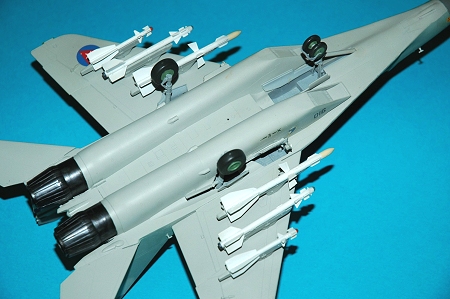 U: That may be, but
the cockpit is not really detailed. Anyway, I have already brush painted
the interior of the canopy with Humbrol 147 Light Grey, and the exterior
with Testors’ 2134 Fulcrum Grey-Green. I usually avoid airbrushing on
canopies as it involves a lot of masking. Besides, I’m pretty good with a
brush, as you can see from my figures.
U: That may be, but
the cockpit is not really detailed. Anyway, I have already brush painted
the interior of the canopy with Humbrol 147 Light Grey, and the exterior
with Testors’ 2134 Fulcrum Grey-Green. I usually avoid airbrushing on
canopies as it involves a lot of masking. Besides, I’m pretty good with a
brush, as you can see from my figures.
B: Yes, but you are not that good with the glue. I must confess, it’s something that has always puzzled me.
U: Modeling is an art, like painting. It’s not engineering.
B: I won’t argue on that. I’m an engineer, and you may say I am biased.
U: You should first go through the “engineering” phase – that is, build a few kits – before moving to the “artistic” phase and experiment with paints, play with complex painting patterns, do extensive weathering and so on. If you stop buying kits you may eventually move to phase one!
B: I won’t argue on that either. (To himself) I hate it when people are right.
U: So, let’s see. I have also prepared the missiles. Academy does not offer anything detailed, or, for that matter, correct in that area, but I don’t really worry about that. I didn’t trust Academy’s suggestions on the paints. I used the instructions from the Ukranian company ICM instead. They concern a 1/72 set: airfields, trucks and modern weapons. When it comes to Soviet weapons, I generally trust the instructions of an Ukranian more than those of a Korean company.
B: So, does that mean that you’re you finished with it?
U: Pretty much, yes. I used silver paint on the antennas and the landing gear. For the aft part of the navigation lights on the wingtips I used yellow, whereas for the front part I used red and green for the port and starboard side respectively. I also painted some black knobs on the electronic box behind the ejection seat, which, by the way, I hope I will receive from you pretty soon…
B: I told you, I’ve painted it, and I will give it to you next time.
U: So. I then applied the decals. I used the insignia and the serial numbers from the Eagle Strike decal sheet and the data markings from Academy. Luckily, in 1/48, not much of the stencils can be seen, since the Cubans write them in their own language.
B: You mean Spanish…
U: Nope, I mean Cuban. They differ a lot, especially in the accent. Speaking Castilian in Cuba is a definite no-no. They’ll think that you are a Spaniard and they’ll give you a hard time. Trust me on that.
B: Now that I think of it, it would be an interesting idea, once you finish the MiG, to put it next to my F-15E Strike Eagle and compare the two. We may even do a dogfight. (Note: isn’t true that modeling brings out the kid of us?)
U: (Exasperated) I give up! You’ll never learn!!! Do you remember what I told you a while ago, about seeing modeling as art? Think of your model as phase one – very good engineering but simple camouflage – gunship grey. When you are good enough you may move to phase two – more complex camouflages. I don’t care about the MiG, I only like the painting scheme, and that’s why I built the kit. Plus it is Cuban and it reminds me of the ‘60s.
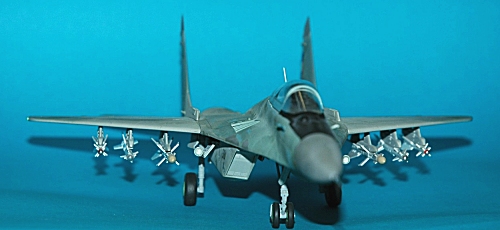 B: Please don’t
start with stories from your childhood. Let’s just stick to the model. So,
what else did you do with the MiG?
B: Please don’t
start with stories from your childhood. Let’s just stick to the model. So,
what else did you do with the MiG?
U: I used Testors’ 1560 dullcote, which is probably the finest matt cote available. It is colorless, dries quickly and gives a good matt finish. Be careful, though, not to make a thick coating, as it may become opaque.
B: What about outlining the panel lines?
U: You’ll have to do it. As a good engineer, you’ll pick a nice sharp HB soft pencil and with your firm hand you’ll do the whole thing.
B: Somehow I get the feeling that you’re too lazy to do it yourself.
U: That’s right. (Pauses. Smiles) So, how’s your girlfriend?
B: (Smiles) You’re mean, you know that?
(Fade out.)
Moral: some people actually build and paint models, instead of arguing about weathering and the authenticity of the colors used! (AMS response: yes, but.......)
| CONCLUSIONS |
The Academy MiG-29 is a good kit. For those AMS modelers, AIRES will come to their rescue regarding upgrade sets and other goodies. But for people like the “Uncle”, the kit is more than reasonable and an inspiration for “other-than-the-usual” Air Forces. For “Mr. Bean” and his likes the kit has its faults and all those “tiny-bitty” errors that need to be fixed………...somewhere, sometime, somehow.
Many thanks to “Barbed Wire” for making the review more theatrical.
April 2005
| REFERENCES |
“Variant Briefing Mikoyan MiG-29”, in World Air Power Journal, Vol. 36 (Spring 1999), pages 108-135
“Air Power Analysis. Central America and the Caribbean”, in World Air Power Journal, Vol. 32 (Spring 1998), pages 142-157
William Green, Gordon Swanborough, The Complete Book of Fighters, Barnes & Noble Books, 1998
Copyright ModelingMadness.com. All rights reserved. No reproduction in part or in whole without express permission from the editor
If you would like your product reviewed fairly and fairly, please contact the editor or see other details in the Note to Contributors.